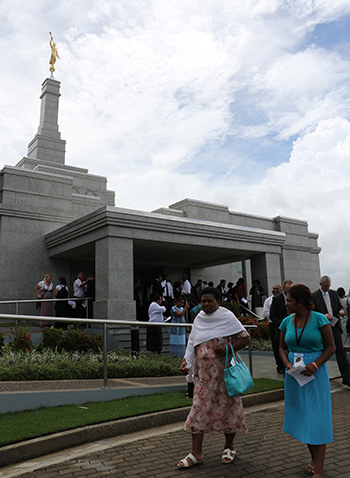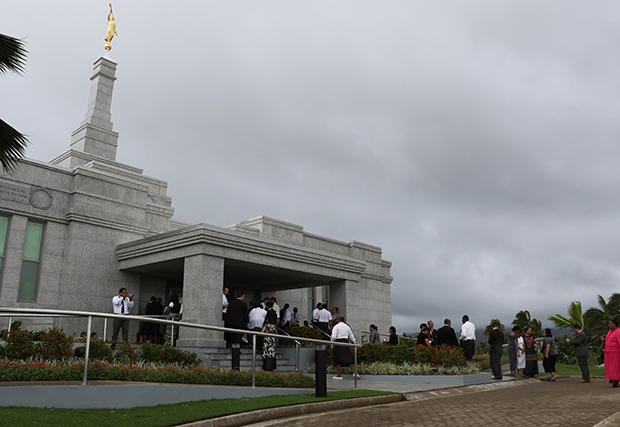Senior Mormon missionary couple based in Taveuni share experiences and photos
The devastating effects of the Category 5 Cyclone Winston three weeks ago are still being felt in some areas of the beautiful islands of Fiji. Senior missionary couples and young single missionaries of The Church of Jesus Christ of Latter-day Saints are giving full-time service in the midst of the devastation.She wrote to her family, “We were overwhelmed as we flew over the Island of Korova. Everything flattened and so unreal. Then over Taveuni. Nature had pruned all the beautiful trees and flowers. It looked like a different island. We could hardly drive through the tree covered roads. People seemed to walk around looking lost and unbelieving. We stopped at the chapel to find homeless families, children and babies sleeping on mats, laundry hanging from the windows.”
Getting to their house was a challenge, but they were grateful to find it only slightly damaged and dirtied. “We were very blessed as houses around us were not as fortunate.”
After cleaning up, “enough to have a place to sleep,” the Vermeerens drove through the muddy roads to those places they could get to, assessing the damages, visiting with the families, and talking with local leaders.
"We have heard there is much damage on the south part of the island. They were in the eye of the cyclone and there are no homes standing in Navakawau and only a few in Vuna."
“The roads had dried somewhat and tractors had cleared a few areas. It was still a mucky, scary ride on narrow washed out roads up the mountain. We literally saw houses torn to bits by raging waves and wind. In Vuna it looked like a war zone. Part of our crew stayed to help remove trees.”
The Vermeerens, along with other missionary couples throughout the damaged islands, were instructed to purchase large quantities of food and water at the local stores to distribute to those in distress.
Hans Sorensen, Manager of Welfare Services for the Church’s Pacific Area, said, “We are focusing [our recovery efforts] on Taveuni Island where three villages were hit particularly hard affecting approximately 1000 people. We are sourcing ten-man tents now.”
The Church is one of several organizations providing relief in Fiji. Australia and New Zealand governments have shipped several tons of food and supplies and hundreds of military troops to assist in distribution and rebuilding. The government of Fiji is well-organised and responded quickly and efficiently to restore power, reopen transportation routes, and distribute goods.
Vermeeren says, “The Australian Army has been helicoptering in men and supplies. Many were given only a few hours’ notice to leave their families before flying out.”
The young Mormon missionaries have also been spending all their time in clean-up and recovery efforts—the Vermeerens’ willing and happy “work crew.”
He adds that 25 schools remain closed; 21 are being used as evacuation centres for the still 19,649 evacuees. The total cost of damages today is estimated at nearly $500 million.
Given the intensity of Cyclone Winston, it is miraculous that there were not more deaths.
Vermeeren said, “We have seen miracle after miracle in the aftermath of Cyclone Winston that raged through our beautiful garden island and left so many destitute.”
She recounts an example: “Nine-year-old Caroline was severely sliced with a piece of roofing aluminium. Her brother put her in a wheelbarrow and somehow was able to push her five kilometres on a dirt road to the nursing station. He saved her life. We have no idea how he was able to do this in the storm. The winds were quoted as being about 350 kilometres [217 miles] an hour!”
“What a wonderful opportunity it has been to work with LDS Charities. We have gained a real respect for the generosity and love our Church provides, especially in times of emergency crises.
"Being in the front lines, watching as they provide for the needs of those without shelter, food, and clothing has been an incredible experience,” says Vermeeren.
“We are so grateful for the support of the Church. [Mission] President Layton and Frank Stanford, LDS Charities, have been here this weekend. They have been organising, planning, and ordering, so we all can move forward in helping as many people as possible. We are grateful for their ongoing and tireless efforts.”
H. David Burton, former Presiding Bishop of The Church of Jesus Christ of Latter-day Saints, in a general conference of the Church in April 2011, said, “As long as the Church has resources, we will not let you go hungry or without clothing or without shelter. We shall do all that we can to assist in the way that the Lord has designated that it should be done.”
To learn more about the work senior missionaries do while on these missions click here.
With credit to Karen Vermeeren for her story and photos.











































